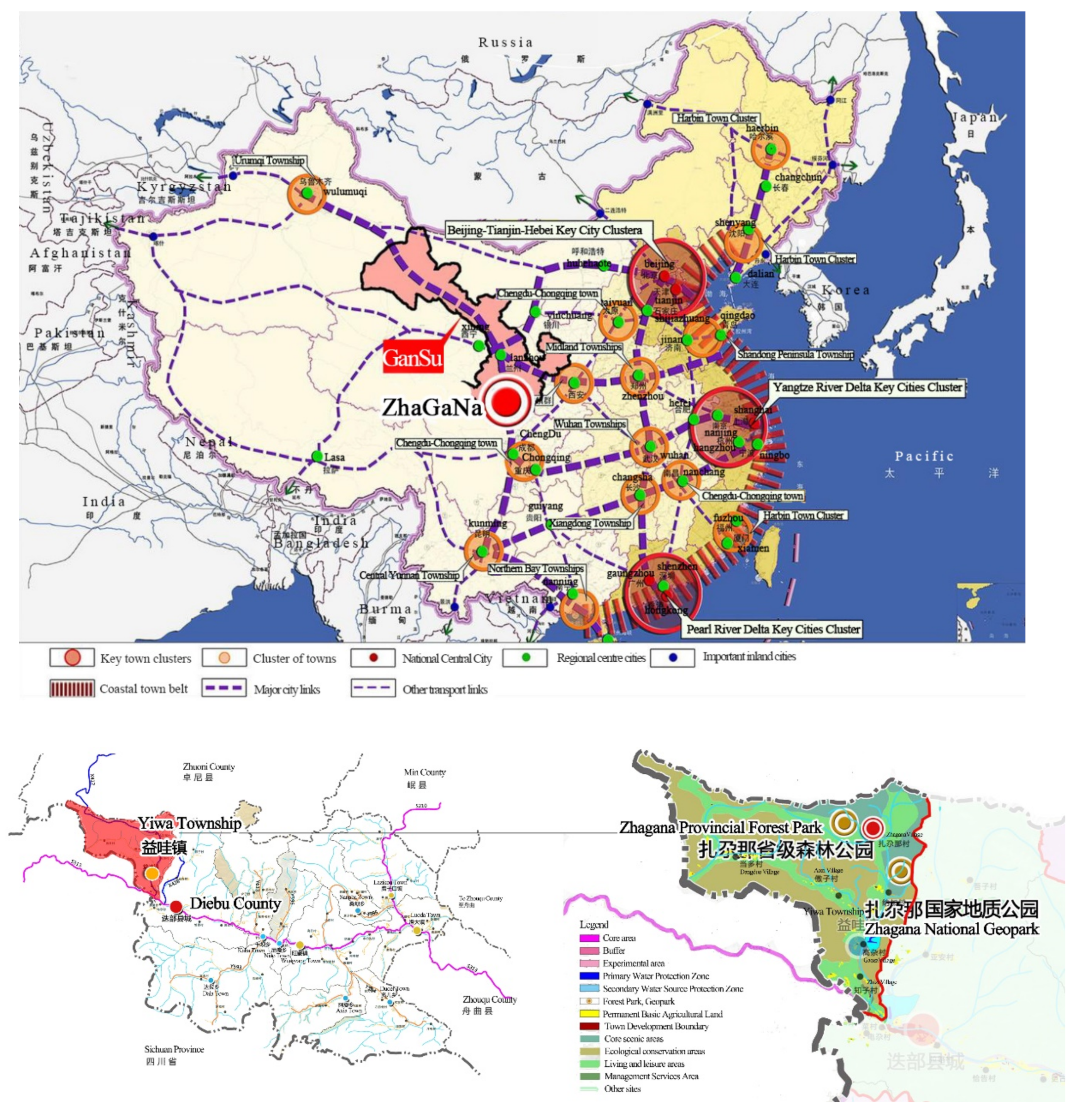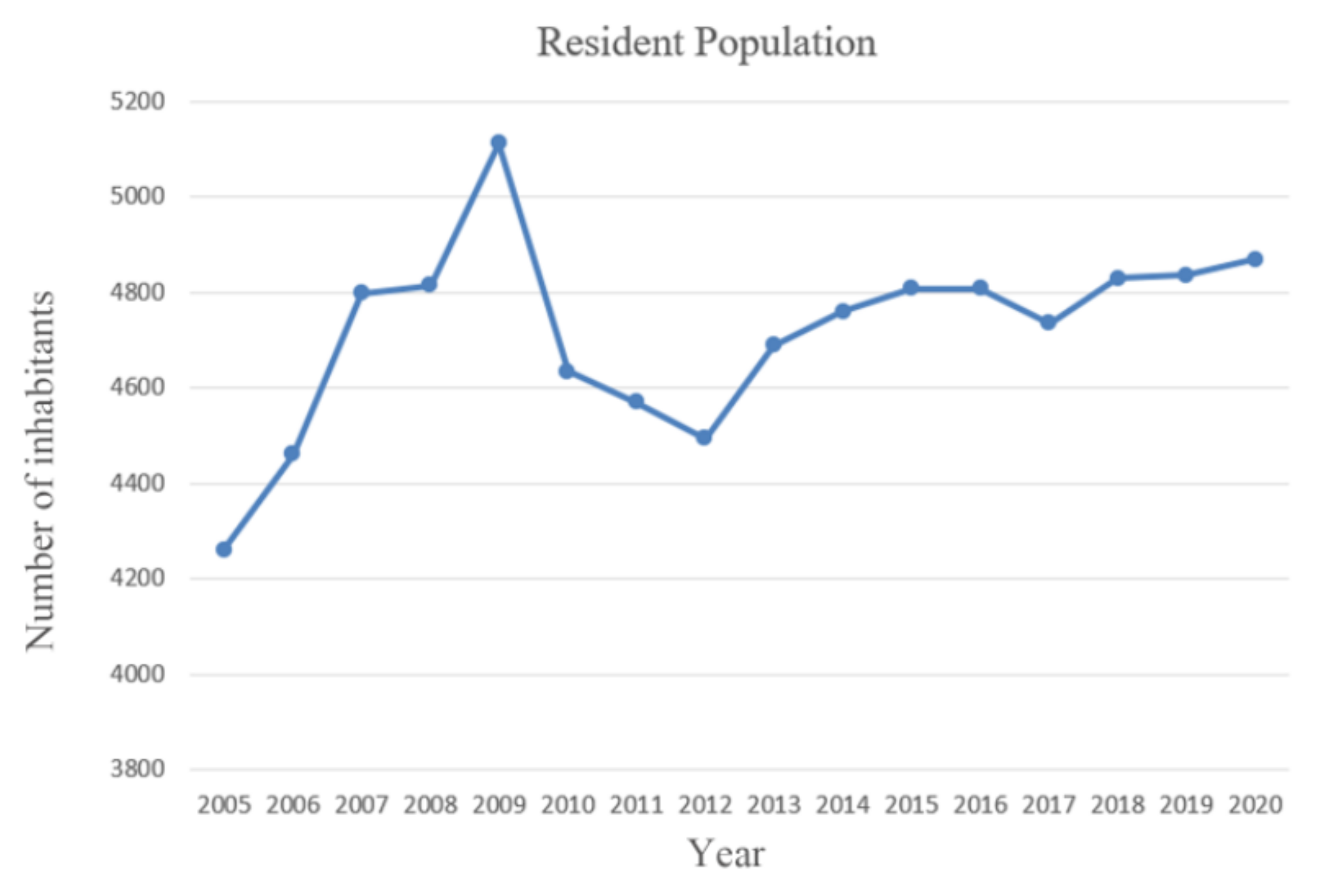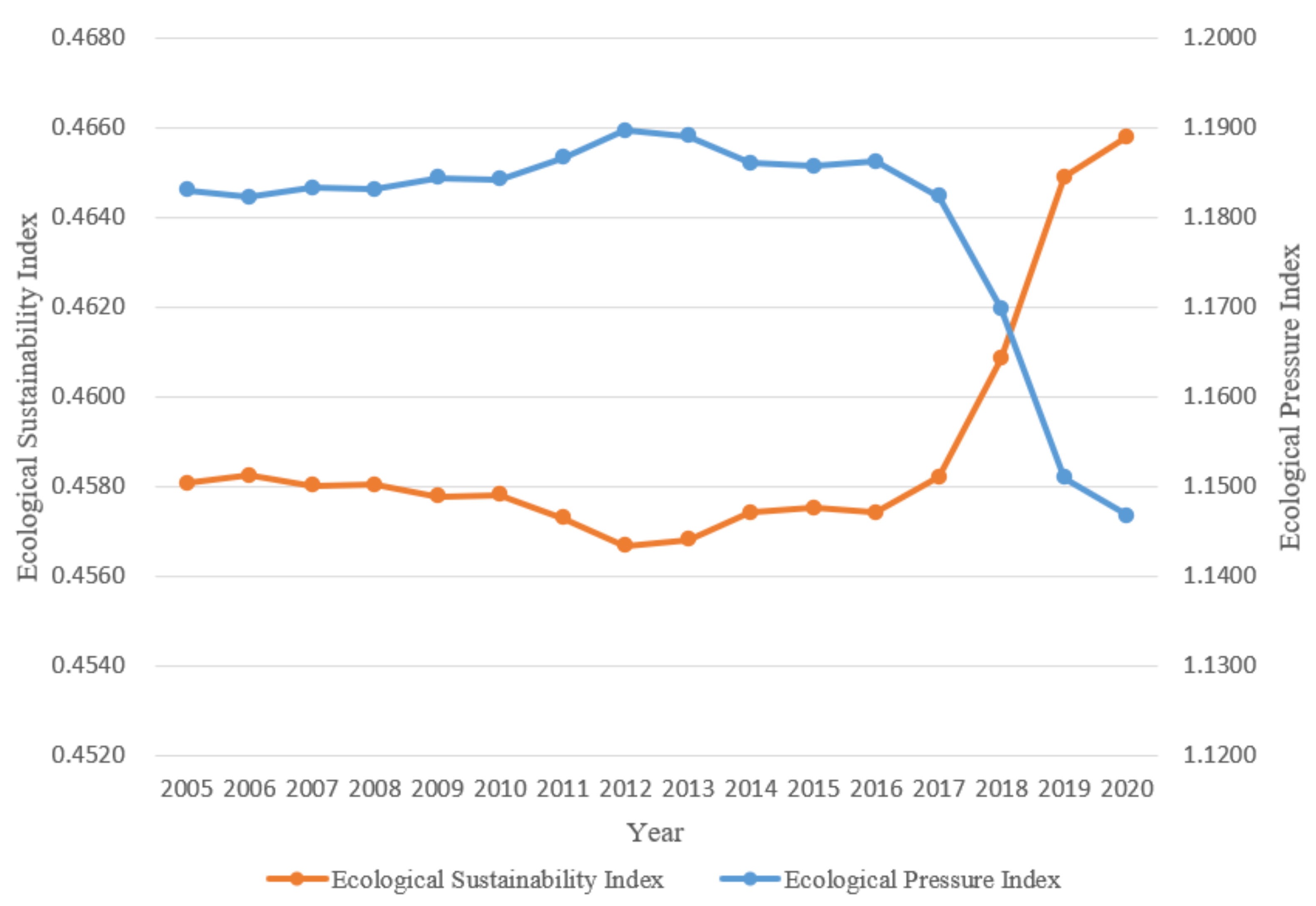Exploration of Rural Agroforestry–Pastoral Complex Systems Based on Ecological Footprint*—Taking Zhagana in Yiwa Township as an Example
Abstract
1. Introduction
2. Research Methodology
2.1. Ecological Footprint Calculation
2.2. Ecological Carrying Capacity Calculation
2.3. Ecological Deficit/Profit and Loss
2.4. Three-Dimensional Ecological Footprint Calculation
2.5. Ecological Pressure Index
2.6. Ecological Sustainability Index
2.7. Ecological Coordination Coefficient
2.8. Ecological Diversity Index and Index of Development Capacity of Ecological and Economic Systems
3. Spatial Identification of Agroforestry–Pastoral Complex Systems
3.1. Overview of the Study Area
3.2. Data Sources
4. Analysis of Results
4.1. Analysis of the Temporal Dynamics of the Ecological Footprint per Capita
4.2. Analysis of the Temporal Dynamics of the Ecological Carrying Capacity per Capita
4.3. Analysis of the Temporal Dynamics of Ecological Surplus and Deficit per Capita in Yiwa Township from 2005 to 2020
4.4. Dynamic Analysis of Three-Dimensional Ecological Footprint
4.5. Dynamic Analysis of Ecological Pressure Index and Ecological Sustainability Index
5. Analysis of Ecological Security Changes in Zhagana
6. Conclusions and Discussion
6.1. Discussion
6.2. Conclusions
Author Contributions
Funding
Institutional Review Board Statement
Informed Consent Statement
Data Availability Statement
Acknowledgments
Conflicts of Interest
References
- Moore, J.; Kissinger, M.; Rees, W.E. An urban metabolism and ecological footprint assessment of Metro Vancouver. J. Environ. Manag. 2013, 124, 51–61. [Google Scholar] [CrossRef] [PubMed]
- Yang, L.; Yang, Y. Evaluation of eco-efficiency in China from 1978 to 2016: Based on a modified ecological footprint model. Sci. Total Environ. 2019, 662, 581–590. [Google Scholar] [CrossRef] [PubMed]
- Salvo, G.; Simas, M.S.; Pacca, S.A.; Guilhoto, J.J.; Tomas, A.R.; Abramovay, R. Estimating the human appropriation of land in Brazil by means of an Input–Output Economic Model and Ecological Footprint analysis. Ecol. Indic. 2015, 53, 78–94. [Google Scholar] [CrossRef]
- Wang, M.; Liu, J.; Wang, J.; Zhao, G. Ecological Footprint and Major Driving Forces in West Jilin Province, Northeast China. Chin. Geogr. Sci. 2010, 20, 434–441. [Google Scholar] [CrossRef]
- Jin, C.; Liu, Y.; Li, Z.; Gong, R.; Huang, M.; Wen, J. Ecological consequences of China’s regional development strategy: Evidence from water ecological footprint in Yangtze River Economic Belt. Environ. Dev. Sustain. 2022, 1–16. [Google Scholar] [CrossRef]
- Liu, Y.; Qu, Y.; Cang, Y.; Ding, X. Ecological security assessment for megacities in the Yangtze River basin: Applying improved emergy-ecological footprint and DEA-SBM model. Ecol. Indic. 2022, 134, 108481. [Google Scholar] [CrossRef]
- Yao, X.; Wang, Z.; Zhang, H. Dynamic changes of the ecological footprint and its component analysis response to land use in Wuhan, China. Sustainability 2016, 8, 329. [Google Scholar] [CrossRef]
- Wackernagel, M.; Onisto, L.; Bello, P.; Linares, A.C.; Falfán IS, L.; Garcıa, J.M.; Guerrero, A.I.S.; Guerrero, M.G.S. National natural capital accounting with the ecological footprint concept. Ecol. Econ. 1999, 29, 375–390. [Google Scholar] [CrossRef]
- Zhou, T.; Wang, Y.P.; Gong, J.Z.; Wang, F.; Feng, Y.F. Model revision and method improvement of ecological footprint. J. Ecol. 2015, 35, 4592–4603. [Google Scholar]
- Koohafkan, P.; Altieri, M.A. Globally Important Agricultural Heritage Systems: A Legacy for the Future; Food and Agriculture Organization of the United Nations: Rome, Italy, 2011. [Google Scholar]
- Kajihara, H.; Zhang, S.; You, W.; Min, Q. Concerns and opportunities around cultural heritage in east Asian globally important agricultural heritage systems (GIAHS). Sustainability 2018, 10, 1235. [Google Scholar]
- Ke, H.; Yang, W.; Liu, X.; Fan, F. Does innovation efficiency suppress the ecological footprint? Empirical evidence from 280 Chinese cities. Int. J. Environ. Res. Public Health 2020, 17, 6826. [Google Scholar] [CrossRef]
- Shi, S.; Hu, B.; Yan, Y.; Li, X.; Zhou, K.; Tang, C.; Xie, B. Dynamic evolution of the ecological carrying capacity of poverty-stricken karst counties based on ecological footprints: A case study in Northwestern Guangxi, China. Int. J. Environ. Res. Public Health 2020, 17, 991. [Google Scholar] [CrossRef]
- Chunling, L.; Memon, J.A.; Thanh, T.L.; Ali, M.; Kirikkaleli, D. The impact of public-private partnership investment in energy and technological innovation on ecological footprint: The case of Pakistan. Sustainability 2021, 13, 10085. [Google Scholar] [CrossRef]
- Guo, J.; Ren, J.; Huang, X.; He, G.; Shi, Y.; Zhou, H. The dynamic evolution of the ecological footprint and ecological capacity of Qinghai Province. Sustainability 2020, 12, 3065. [Google Scholar] [CrossRef]
- Kirikkaleli, D.; Adebayo, T.S.; Khan, Z.; Ali, S. Does globalization matter for ecological footprint in Turkey? Evidence from dual adjustment approach. Environ. Sci. Pollut. Res. 2021, 28, 14009–14017. [Google Scholar] [CrossRef]
- Xiao, Y.; Ou, Y.; Qu, X.; Zhang, L.; Zhang, X.; Jun, X. Determining the Regional Carrying Capacity of the Wuhan City Circle Based on the Improved Ecological Footprint Method. JAWRA J. Am. Water Resour. Assoc. 2021, 57, 585–601. [Google Scholar] [CrossRef]
- Zhang, H.; Xiao, Y.; Deng, Y. Island ecosystem evaluation and sustainable development strategies: A case study of the Zhoushan Archipelago. Glob. Ecol. Conserv. 2021, 28, e01603. [Google Scholar] [CrossRef]
- Tong, S.; Zhiming, F.; Yanzhao, Y.; Yumei, L.; Yanjuan, W. Research on land resource carrying capacity: Progress and prospects. J. Resour. Ecol. 2018, 9, 331–340. [Google Scholar] [CrossRef]
- Guo, X.R.; Yang, J.R.; Mao, X.Q. Calculation and analysis of urban ecological footprint: A case study of Guangzhou. Geogr. Res. 2003, 22, 654–662. [Google Scholar]
- Wackernagel, M.; Rees, W. Our Ecological Footprint: Reducing Human Impact on the Earth; New Society Publishers: Gabriola, BC, Canada, 1998. [Google Scholar]
- Jeswani, H.K.; Azapagic, A. Water footprint: Methodologies and a case study for assessing the impacts of water use. J. Clean. Prod. 2011, 19, 1288–1299. [Google Scholar] [CrossRef]
- Mancini, M.S.; Galli, A.; Niccolucci, V.; Lin, D.; Bastianoni, S.; Wackernagel, M.; Marchettini, N. Ecological Footprint: Refining the carbon Footprint calculation. Ecol. Indic. Integr. Monit. Assess. Manag. 2016, 61, 390–403. [Google Scholar] [CrossRef]
- Liu, Z.; Li, B.; Chen, M.; Li, T. Evaluation on sustainability of water resource in karst area based on the emergy ecological footprint model and analysis of its driving factors: A case study of Guiyang city, China. Environ. Sci. Pollut. Res. 2021, 28, 49232–49243. [Google Scholar] [CrossRef] [PubMed]
- Chen, H.S. Evaluation and analysis of eco-security in environmentally sensitive areas using an emergy ecological footprint. Int. J. Environ. Res. Public Health 2017, 14, 136. [Google Scholar] [CrossRef] [PubMed]
- Dietz, T.; Rosa, E.A. Effects of population and affluence on CO2 emissions. Proc. Natl. Acad. Sci. USA 1997, 94, 175–179. [Google Scholar] [CrossRef] [PubMed]
- Qureshi, M.I.; Elashkar, E.E.; Shoukry, A.M.; Aamir, A.; Mahmood, N.H.N.; Rasli, A.M.; Zaman, K. Measuring the ecological footprint of inbound and outbound tourists: Evidence from a panel of 35 countries. Clean Technol. Environ. Policy 2019, 21, 1949–1967. [Google Scholar] [CrossRef]
- Guo, J. Evaluation and Prediction of Ecological Sustainability in the Upper Reaches of the Yellow River Based on Improved Three-Dimensional Ecological Footprint Model. Int. J. Environ. Res. Public Health 2022, 19, 13550. [Google Scholar] [CrossRef]
- Yin, Y.; Han, X.; Wu, S. Spatial and temporal variations in the ecological footprints in Northwest China from 2005 to 2014. Sustainability 2017, 9, 597. [Google Scholar] [CrossRef]
- Wei, S.; Pan, J.; Liu, X. Landscape ecological safety assessment and landscape pattern optimization in arid inland river basin: Take Ganzhou District as an example. Hum. Ecol. Risk Assess. Int. J. 2020, 26, 782–806. [Google Scholar] [CrossRef]
- Wang, G. Evaluation and Analysis of Sustainable Development of Regional Ecological Economy Based on Ecological Footprint Model. Ekoloji 2019, 28, 2099–2103. [Google Scholar]
- Li, P.; Zhang, R.; Wei, H.; Xu, L. Assessment of physical quantity and value of natural capital in China since the 21st century based on a modified ecological footprint model. Sci. Total Environ. 2022, 806, 150676. [Google Scholar] [CrossRef]
- Rees, W.E. Ecological Footprints and Appropriated Carrying Capacity: What Urban Economics Leaves Out; The Earthscan Reader in Rural–Urban Linkages; Routledge: London, UK, 2018; pp. 285–297. [Google Scholar]
- Ecotourism and Environmental Sustainability: Principles and Practice; Ashgate Publishing, Ltd.: Farnham, UK, 2009.
- Rees, W. Ecological Footprint//Companion to Environmental Studies; Routledge: London, UK, 2018; pp. 43–48. [Google Scholar]







| Land Type | Equilibrium Factors | Yield Factors |
|---|---|---|
| Arable land | 2.39 | 1.66 |
| Grassland | 0.51 | 0.19 |
| Woodland | 1.25 | 1.1 |
| Water | 0.41 | 0.2 |
| Construction land | 2.39 | 2.8 |
| Fossil energy land | 1.25 | 0 |
| Level | I | II | III | IV | V |
|---|---|---|---|---|---|
| <0.50 | 0.51–1.00 | 1.01–1.50 | 1.51–2.00 | >2.00 | |
| Representation status | Secure | More secure | Less secure | Insecure | Extremely insecure |
| Ecological Footprint Components | Land Type | Category | Indicator |
|---|---|---|---|
| Ecological Resource Account | Arable land | Agricultural products | Wheat, rice, maize, soybeans, cotton, potatoes, rapeseed, peanuts, vegetables, poultry and eggs (grains, vegetables, oilseeds, herbs, sugar beets, pork) |
| Grassland | Livestock products | Lamb, beef, sheep’s wool, milk, poultry and eggs, meat, dairy, wool, honey | |
| Woodland | Forest Products | Fruits (apples, pears, grapes, peaches, apricots), walnuts, peppercorns, wood | |
| Water | Aquatic products | Water products | |
| Energy accounts | Construction land | Electricity | Electricity |
| Fossil energy land | Fossil fuels | Coal, coke, crude oil, natural gas (gasoline, paraffin, diesel) |
| Year | Arable Land (hm2/Person) | Woodland (hm2/Person) | Grassland (hm2/Person) | Water (hm2/Person) | Fossil Fuel land (hm2/Person) | Construction Land (hm2/Person) | Per Capita Ecological Footprint (hm2/Person) |
|---|---|---|---|---|---|---|---|
| 2005 | 0.2617 | 4.8656 | 2.2642 | 0.0042 | 0.0103 | 0.0216 | 7.4276 |
| 2006 | 0.2462 | 4.6569 | 2.1590 | 0.0042 | 0.0107 | 0.0223 | 7.0994 |
| 2007 | 0.2204 | 4.3368 | 2.0054 | 0.0041 | 0.0096 | 0.0201 | 6.5965 |
| 2008 | 0.2157 | 4.3332 | 1.9958 | 0.0037 | 0.0093 | 0.0194 | 6.5771 |
| 2009 | 0.2014 | 4.0968 | 1.8771 | 0.0017 | 0.0048 | 0.0109 | 6.1927 |
| 2010 | 0.2190 | 4.5295 | 2.0685 | 0.0016 | 0.0050 | 0.0114 | 6.8351 |
| 2011 | 0.2124 | 4.5959 | 2.0996 | 0.0010 | 0.0038 | 0.0091 | 6.9219 |
| 2012 | 0.2068 | 2.1378 | 0.0009 | 0.0021 | 0.0058 | 7.0253 | |
| 2013 | 0.1997 | 4.4770 | 2.0489 | 0.0006 | 0.0026 | 0.0067 | 6.7355 |
| 2014 | 0.2085 | 4.4134 | 2.0153 | 0.0005 | 0.0030 | 0.0075 | 6.6482 |
| 2015 | 0.2043 | 4.3749 | 1.9935 | 0.0003 | 0.0034 | 0.0082 | 6.5845 |
| 2016 | 0.1964 | 4.3808 | 1.9927 | 0.0001 | 0.0041 | 0.0095 | 6.5835 |
| 2017 | 0.1892 | 4.4531 | 2.0197 | 0.0001 | 0.0120 | 0.0247 | 6.6987 |
| 2018 | 0.1782 | 4.3646 | 1.9746 | 0.0001 | 0.0334 | 0.0655 | 6.6164 |
| 2019 | 0.1797 | 4.3602 | 1.9587 | 0.0001 | 0.0625 | 0.1212 | 6.6824 |
| 2020 | 0.1834 | 4.3455 | 1.9358 | 0.0012 | 0.0649 | 0.1257 | 6.6564 |
| Year | Arable Land (hm2/Person) | Woodland (hm2/Person) | Grassland (hm2/Person) | Water (hm2/Person) | Fossil Fuel Land (hm2/Person) | Construction Land (hm2/Person) | Per Capita Ecological Carrying Capacity (hm2/Person) |
|---|---|---|---|---|---|---|---|
| 2005 | 0.4345 | 5.3522 | 0.4302 | 0.0008 | 0.0000 | 0.0604 | 6.2781 |
| 2006 | 0.4088 | 5.1226 | 0.4102 | 0.0008 | 0.0000 | 0.0624 | 6.0048 |
| 2007 | 0.3659 | 4.7705 | 0.3810 | 0.0008 | 0.0000 | 0.0562 | 5.5745 |
| 2008 | 0.3580 | 4.7665 | 0.3792 | 0.0007 | 0.0000 | 0.0543 | 5.5588 |
| 2009 | 0.3343 | 4.5065 | 0.3566 | 0.0003 | 0.0000 | 0.0304 | 5.2282 |
| 2010 | 0.3636 | 4.9824 | 0.3930 | 0.0003 | 0.0000 | 0.0320 | 5.7713 |
| 2011 | 0.3525 | 5.0555 | 0.3989 | 0.0002 | 0.0000 | 0.0256 | 5.8327 |
| 2012 | 0.3432 | 5.1392 | 0.4062 | 0.0002 | 0.0000 | 0.0163 | 5.9051 |
| 2013 | 0.3315 | 4.9247 | 0.3893 | 0.0001 | 0.0000 | 0.0187 | 5.6643 |
| 2014 | 0.3461 | 4.8547 | 0.3829 | 0.0001 | 0.0000 | 0.0211 | 5.6049 |
| 2015 | 0.3391 | 4.8124 | 0.3788 | 0.0001 | 0.0000 | 0.0229 | 5.5533 |
| 2016 | 0.3259 | 4.8189 | 0.3786 | 0.0000 | 0.0000 | 0.0266 | 5.5500 |
| 2017 | 0.3140 | 4.8984 | 0.3837 | 0.0000 | 0.0000 | 0.0692 | 5.6653 |
| 2018 | 0.2958 | 4.8011 | 0.3752 | 0.0000 | 0.0000 | 0.1835 | 5.6555 |
| 2019 | 0.2984 | 4.7962 | 0.3722 | 0.0000 | 0.0000 | 0.3392 | 5.8060 |
| 2020 | 0.3044 | 4.7800 | 0.3678 | 0.0002 | 0.0000 | 0.3519 | 5.8044 |
| Time/Year | Ecological Footprint per Capita | Ecological Carrying Capacity per Capita | Per Capita Ecological Profit and Loss |
|---|---|---|---|
| 2010 | 3.47 | 3.14 | 0.33 |
| 2015 | 5.60 | 4.82 | 0.78 |
| 2020 | 6.63 | 6.11 | 0.53 |
| Year | Arable Land (hm2/Person) | Woodland (hm2/Person) | Grassland (hm2/Person) | Water (hm2/Person) | Fossil Fuel Land (hm2/Person) | Construction Land (hm2/Person) | Ecological Deficit (hm2/Person) |
|---|---|---|---|---|---|---|---|
| 2005 | 0.1728 | 0.4866 | −1.8340 | −0.0034 | −0.0103 | 0.0388 | 1.1495 |
| 2006 | 0.1625 | 0.4657 | −1.7488 | −0.0034 | −0.0107 | 0.0401 | 1.0946 |
| 2007 | 0.1455 | 0.4337 | −1.6244 | −0.0033 | −0.0096 | 0.0361 | 1.0220 |
| 2008 | 0.1423 | 0.4333 | −1.6166 | −0.0030 | −0.0093 | 0.0349 | 1.0183 |
| 2009 | 0.1329 | 0.4097 | −1.5204 | −0.0014 | −0.0048 | 0.0195 | 0.9645 |
| 2010 | 0.1446 | 0.4529 | −1.6754 | −0.0013 | −0.0050 | 0.0206 | 1.0637 |
| 2011 | 0.1402 | 0.4596 | −1.7007 | −0.0008 | −0.0038 | 0.0164 | 1.0891 |
| 2012 | 0.1365 | 0.4672 | −1.7316 | −0.0007 | −0.0021 | 0.0105 | 1.1202 |
| 2013 | 0.1318 | 0.4477 | −1.6596 | −0.0005 | −0.0026 | 0.0121 | 1.0712 |
| 2014 | 0.1376 | 0.4413 | −1.6324 | −0.0004 | −0.0030 | 0.0136 | 1.0433 |
| 2015 | 0.1348 | 0.4375 | −1.6147 | −0.0002 | −0.0034 | 0.0147 | 1.0313 |
| 2016 | 0.1296 | 0.4381 | −1.6141 | −0.0001 | −0.0041 | 0.0171 | 1.0335 |
| 2017 | 0.1248 | 0.4453 | −1.6359 | −0.0001 | −0.0120 | 0.0445 | 1.0334 |
| 2018 | 0.1176 | 0.4365 | −1.5994 | −0.0001 | −0.0334 | 0.1179 | 0.9609 |
| 2019 | 0.1186 | 0.4360 | −1.5866 | −0.0001 | −0.0625 | 0.2181 | 0.8764 |
| 2020 | 0.1210 | 0.4345 | −1.5680 | −0.0010 | −0.0649 | 0.2262 | 0.8520 |
| Year | Ecological Pressure Index | Degree |
|---|---|---|
| 2010 | 1.10 | III |
| 2015 | 1.16 | III |
| 2020 | 1.09 | III |
| Time | Ecological Coordination Factor | Ecosystem Development Capability Index | Ecological Footprint Diversity Index |
|---|---|---|---|
| 2010 | 1.41 | 2.98 | 0.86 |
| 2015 | 1.41 | 4.04 | 0.72 |
| 2020 | 1.41 | 3.22 | 0.49 |
Publisher’s Note: MDPI stays neutral with regard to jurisdictional claims in published maps and institutional affiliations. |
© 2022 by the authors. Licensee MDPI, Basel, Switzerland. This article is an open access article distributed under the terms and conditions of the Creative Commons Attribution (CC BY) license (https://creativecommons.org/licenses/by/4.0/).
Share and Cite
Zhang, S.; Xie, X. Exploration of Rural Agroforestry–Pastoral Complex Systems Based on Ecological Footprint*—Taking Zhagana in Yiwa Township as an Example. Sustainability 2022, 14, 14442. https://doi.org/10.3390/su142114442
Zhang S, Xie X. Exploration of Rural Agroforestry–Pastoral Complex Systems Based on Ecological Footprint*—Taking Zhagana in Yiwa Township as an Example. Sustainability. 2022; 14(21):14442. https://doi.org/10.3390/su142114442
Chicago/Turabian StyleZhang, Shiwen, and Xiaoling Xie. 2022. "Exploration of Rural Agroforestry–Pastoral Complex Systems Based on Ecological Footprint*—Taking Zhagana in Yiwa Township as an Example" Sustainability 14, no. 21: 14442. https://doi.org/10.3390/su142114442
APA StyleZhang, S., & Xie, X. (2022). Exploration of Rural Agroforestry–Pastoral Complex Systems Based on Ecological Footprint*—Taking Zhagana in Yiwa Township as an Example. Sustainability, 14(21), 14442. https://doi.org/10.3390/su142114442





